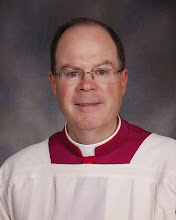
In a quarter century of preaching, I have never had more trouble writing a homily than I did this weekend. What you’re hearing is my fourth try—assuming I don’t have to tear this up and try a fifth time.
I’m not sure why it’s been so difficult. Part of the reason, I think, is that death has loomed large in the parish this week. On Thursday night I got a call that an elderly parishioner had died without warning. A week earlier I administered the sacraments to another elderly woman; although she was not thought to be in any immediate danger, she died that night. And on Tuesday afternoon I anointed a 41-year old at the hospital, who died less than two hours later.
On top of that, someone I admire and like very much has been told that death is not that far away.
So the thought of saying one false word, of uttering platitudes, or failing to help people understand this crucial Gospel makes me shudder.
Last night I dropped in on the youth group as they watched the movie version of Narnia, the C.S. Lewis classic. It’s filled with special effects and all the wonders that modern technology can add to a children’s story. Right on cue I got a bit teary when Aslan, the slain lion, rises from the dead.
The story of the raising of Lazarus, by comparison, is tame. Jesus doesn’t roar like the victorious Aslan; he simply calls Lazarus from death to life.
Yet it’s the raising of Lazarus, not the lion, that should make us weep for joy. Because this story isn’t about Lazarus at all. It’s about me, and you, and everyone we’ve loved and lost or will ever lose.
In just two weeks we’ll once again be celebrating Christ’s victory over death. But the Church wants to make sure—even before Easter—that we know what this victory brings to us. The raising of Lazarus shows us that Jesus brings life. This is so important that Jesus allows his friends to suffer just so they—and we—would get the point.
The mourners would prefer Jesus to prevent death. But he shows a power much greater by conquering death.
Death, I believe, is an almost-universal fear. From childhood to old age, we worry about dying or losing those we love. From childhood I worried about losing my father too early, as he had lost his. On her engagement day, a dear friend confided to me her fear that the man she loved so much would one die have to die.
And as we age, death is never far from our thoughts.
To some extent, this is natural. Jesus recognizes ordinary human worry and sadness. He doesn’t scold Martha and Mary for their tears—he joins them. So don’t get me wrong. Christians have emotions, and those emotions include anxiety and grief. But we must balance those emotions with our faith in two things: first, the presence of Jesus in all our sorrows, and second, his promise of life that never ends.
Jesus had to permit Martha and Mary to suffer for the sake of his mission. But does he abandon them? Hardly—he’s right beside them in their grief. He consoles them and brings them to understand the mystery they are living out.
Jesus says “come out” to Lazarus. Come out of the darkness of your tomb. But most of all, come out to the light of faith your sisters and friends have found while you lay dead. Come out into the light that will never end, and receive the life that no illness can ever take away from you.
Jesus says the same to each of us. “Come out from your fear of death into the light of faith that overpowers fear with hope. Carry on the same heart to heart conversation with me that Mary did; tell me how you feel. Talk to me like Martha did, and learn from me that I am the resurrection.”
Christians bleed, and Christians die. But the Son of God did not come into the world to give them temporary relief or to patch them up. He promised instead no more death and no more weeping, in the Kingdom that even now has begun.
Jesus said to Martha “I am the resurrection.” When we see that proved at Easter, let’s remember the whole sentence. He is not only “the resurrection” but “the life.” Life for the world, life for the dying, and life for the dead.
If we can just carry that thought—Jesus, our resurrection and our life—I won’t need to try a fifth homily.

No comments:
Post a Comment